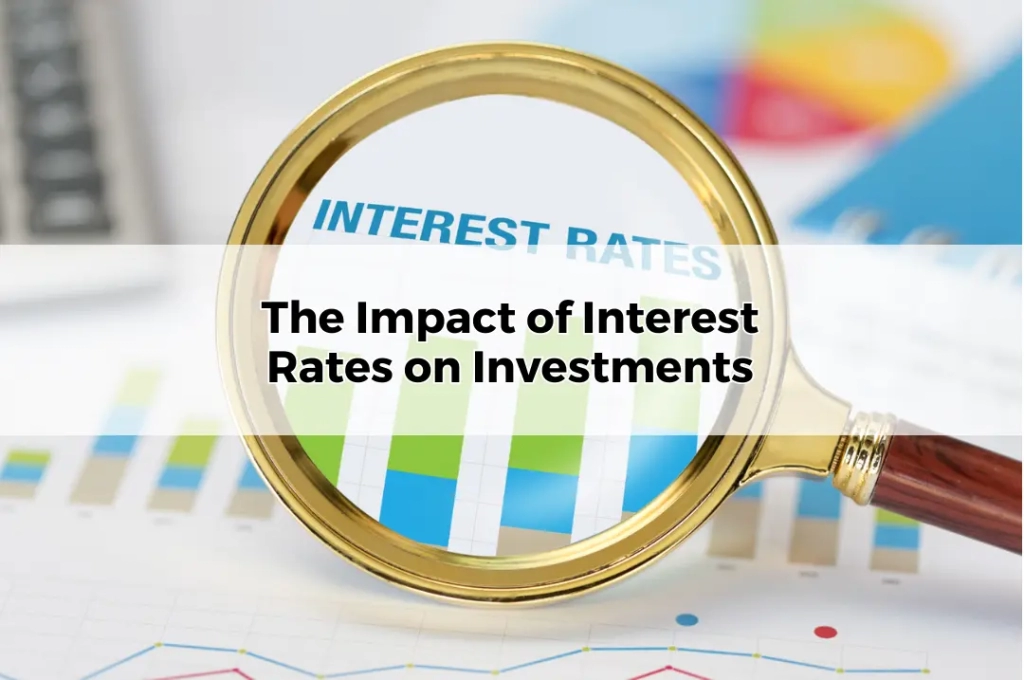The Impact of Interest Rates on Investments
Table of Contents
ToggleInterest rates are one of the most influential factors in the world of finance, with a profound impact on the economy and financial markets. Whether you’re an individual investor, a retiree, or someone saving for a major life event, understanding how interest rates affect investments is crucial. Changes in interest rates can alter the landscape of investment returns, influencing everything from the share market to bond prices, real estate values, and even currency exchange rates. For Australian investors, staying informed about interest rate trends is key to making strategic investment decisions.
Understanding the Role of Interest Rates in the Economy
Interest rates serve as the price of borrowing money and the reward for saving it. Set primarily by central banks, these rates influence economic activity by affecting consumer spending, business investment, and inflation. When interest rates rise, borrowing becomes more expensive, which can slow down economic growth. Conversely, lower interest rates make borrowing cheaper, potentially spurring economic activity. For investors, the ebb and flow of interest rates can create opportunities or pose challenges, depending on the structure of their investment portfolios.
Why Investors Need to Monitor Interest Rate Movements
Interest rate movements are not random; they are the result of deliberate policy decisions aimed at managing economic growth and inflation. For investors, understanding these movements is essential. A change in interest rates can lead to significant shifts in asset prices, affecting both short-term returns and long-term investment strategies. By keeping an eye on interest rate trends, investors can better position themselves to protect their portfolios and capitalise on emerging opportunities.
The Basics of Interest Rates
What Are Interest Rates?
Interest rates represent the cost of borrowing money or the return on invested capital. They are expressed as a percentage and can vary depending on the type of loan or investment. For instance, the interest rate on a home mortgage may differ from the rate on a corporate bond or a government security. In the financial markets, interest rates play a critical role in determining the value of assets and the cost of financing.
How Central Banks Influence Interest Rates
Central banks, such as the Reserve Bank of Australia (RBA), influence interest rates through monetary policy. By adjusting the cash rate, which is the rate at which banks lend to each other overnight, the RBA can control the overall level of interest rates in the economy. When the central bank raises the cash rate, borrowing costs increase, which can dampen economic activity and reduce inflationary pressures. Conversely, lowering the cash rate makes borrowing cheaper, stimulating spending and investment.
The Relationship Between Interest Rates and Inflation
Understanding Inflation and Its Economic Impact
Inflation is the rate at which the general level of prices for goods and services rises, eroding the purchasing power of money. Central banks closely monitor inflation because it can destabilise the economy if it gets out of control. When inflation is high, central banks may raise interest rates to cool down the economy and bring inflation back to target levels. Conversely, when inflation is low, they may lower rates to encourage spending and investment.
How Interest Rates Are Used to Control Inflation
Interest rates are one of the primary tools used by central banks to control inflation. By raising rates, central banks make borrowing more expensive, which can reduce consumer spending and business investment, slowing down the economy and reducing inflationary pressures. Conversely, lowering rates can encourage borrowing and spending, potentially increasing inflation if the economy overheats. For investors, understanding this relationship is crucial, as changes in interest rates can signal shifts in the broader economic environment.
The Effect of Interest Rates on Different Asset Classes
Bonds
Bonds are particularly sensitive to changes in interest rates. When rates rise, the price of existing bonds typically falls, as new bonds are issued with higher yields, making older bonds less attractive. Conversely, when rates fall, existing bonds with higher yields become more valuable, pushing their prices up. This inverse relationship between interest rates and bond prices is fundamental to bond investing.
Equities
Interest rates also affect equities, though the relationship is more complex. Higher interest rates can lead to higher borrowing costs for companies, which can reduce profitability and, in turn, lower share prices. Additionally, higher rates can make bonds more attractive relative to shares, leading to a shift in investor preferences. On the other hand, lower interest rates can boost corporate earnings by reducing financing costs, potentially leading to higher share prices.
Real Estate
Real estate investments are heavily influenced by interest rates, particularly through the cost of mortgage financing. When interest rates rise, the cost of borrowing increases, which can reduce demand for property and lead to lower property values. Conversely, lower rates make borrowing more affordable, potentially boosting demand for real estate and driving up property prices.
Cash and Fixed Deposits
Cash and fixed deposits are generally considered safe investments, but their returns are directly tied to interest rates. In a high-interest-rate environment, cash and fixed deposits can offer attractive returns with minimal risk. However, in a low-rate environment, the returns on these investments may not keep pace with inflation, eroding their real value over time.
Interest Rates and the Share Market
How Rising Rates Affect Share Prices
Rising interest rates can have a dampening effect on share prices for several reasons. First, higher rates increase the cost of borrowing for companies, which can squeeze profit margins and reduce earnings growth. Second, higher rates make bonds and other fixed-income investments more attractive, potentially leading to a shift in investor funds away from equities. Finally, higher rates can reduce consumer spending, impacting the revenues of companies, particularly those in interest-sensitive sectors such as consumer goods and housing.
The Influence of Lower Rates on Equity Markets
Conversely, lower interest rates can provide a boost to equity markets. Lower borrowing costs can enhance corporate profitability, while also making shares more attractive relative to bonds. Additionally, lower rates can stimulate consumer spending, benefiting companies across various sectors. However, while lower rates can support higher share prices, they can also lead to inflated valuations, which may increase the risk of a market correction.
The Impact of Interest Rates on Bond Investments
Inverse Relationship Between Interest Rates and Bond Prices
The relationship between interest rates and bond prices is one of the most fundamental concepts in investing. When interest rates rise, the prices of existing bonds fall because new bonds are issued with higher yields, making the older bonds less competitive. Conversely, when interest rates decline, existing bonds with higher fixed rates become more valuable, driving up their prices. This inverse relationship means that bond investors must be particularly vigilant about interest rate trends.
Duration Risk: Managing Bond Portfolio Sensitivity
Duration is a measure of a bond’s sensitivity to changes in interest rates. Bonds with longer durations are more sensitive to interest rate changes, meaning their prices will fluctuate more in response to rate movements. Managing duration risk is crucial for bond investors, particularly in a volatile interest rate environment. Investors may choose to shorten the duration of their bond portfolios in anticipation of rising rates to minimise potential losses.
Real Estate Investments and Interest Rates
Mortgage Rates and Property Affordability
Interest rates have a direct impact on mortgage rates, which in turn affect property affordability. Higher interest rates lead to higher mortgage payments, which can reduce the number of potential buyers and put downward pressure on property prices. On the other hand, lower interest rates make mortgages more affordable, increasing demand for real estate and potentially driving up property values.
How Interest Rates Influence Real Estate Investment Decisions
Investors in real estate must consider the current and projected interest rate environment when making investment decisions. In a rising interest rate environment, the cost of financing real estate investments increases, which can reduce returns. Conversely, in a low-interest-rate environment, the cost of borrowing is lower, potentially making real estate investments more attractive. However, investors must also consider the potential for rate increases in the future, which could impact the long-term profitability of their investments.
Interest Rates and Currency Markets
The Connection Between Interest Rates and Exchange Rates
Interest rates play a significant role in determining exchange rates between currencies. Higher interest rates tend to attract foreign capital, leading to an appreciation of the local currency. Conversely, lower interest rates may lead to capital outflows and a depreciation of the currency. For international investors, changes in exchange rates can have a significant impact on the returns of foreign investments.
Implications for International Investors
For Australian investors with exposure to foreign assets, changes in interest rates can impact both the value of their investments and the returns when converted back into Australian dollars. Understanding the relationship between interest rates and currency movements is crucial for managing the risks associated with international investing.
The Role of Interest Rates in Retirement Planning
How Changing Rates Affect Superannuation Returns
Interest rates can have a significant impact on the returns generated by superannuation funds, particularly those invested in fixed-income assets. Lower interest rates can reduce the income generated by bonds and cash holdings, potentially leading to lower overall returns. Conversely, higher interest rates can boost returns from these assets, though they may also lead to volatility in other parts of the portfolio, such as equities.
Adjusting Retirement Strategies in Response to Rate Movements
Retirees and those nearing retirement must consider the impact of interest rate changes on their investment strategy. In a low-interest-rate environment, retirees may need to seek alternative sources of income, such as dividend-paying shares or annuities, to supplement their retirement income. Conversely, in a rising-rate environment, retirees may benefit from increasing allocations to fixed-income assets, which can provide higher yields.
Strategies for Investing in a Rising Interest Rate Environment
Diversifying Across Asset Classes
In a rising interest rate environment, diversification becomes even more important. By spreading investments across different asset classes, such as equities, bonds, real estate, and cash, investors can reduce the impact of rising rates on their overall portfolio. Each asset class responds differently to interest rate changes, so a well-diversified portfolio can help balance risk and reward.
The Importance of Liquidity and Flexibility
Liquidity and flexibility are crucial in a rising interest rate environment. Investors should consider maintaining a portion of their portfolio in liquid assets that can be easily adjusted in response to changing market conditions. Additionally, being flexible in investment strategies, such as adjusting duration in a bond portfolio or reallocating assets in response to rate changes, can help manage risk.
Considering Shorter Duration Bonds and Floating Rate Instruments
In a rising interest rate environment, shorter duration bonds and floating rate instruments can be attractive options. Shorter duration bonds are less sensitive to interest rate changes, reducing the risk of price declines. Floating rate instruments, which adjust their interest payments based on changes in market rates, can provide a hedge against rising rates, offering potentially higher returns as rates increase.
Investing in a Low-Interest Rate Environment
Seeking Higher Yields
In a low-interest-rate environment, investors may be tempted to seek higher yields through riskier assets, such as high-yield bonds, real estate investment trusts (REITs), or dividend-paying shares. While these assets can offer higher returns, they also come with increased risk. Investors must carefully evaluate the risk-reward trade-off and consider whether the potential for higher returns justifies the additional risk.
The Role of Dividends and Growth Shares
Dividends and growth shares can play an important role in a low-interest-rate environment. Dividend-paying shares can provide a steady income stream, while growth shares offer the potential for capital appreciation. However, investors should be mindful of the valuations of these shares, as low interest rates can lead to inflated prices, increasing the risk of future corrections.
The Importance of Professional Advice in Managing Interest Rate Risk
Why Investors Should Consult a Financial Adviser
Interest rate movements can have complex and far-reaching effects on investment portfolios. Consulting a financial adviser can provide investors with the expertise needed to navigate these changes effectively. A financial adviser can help assess the impact of interest rate changes on individual investments, develop strategies to manage risk, and ensure that portfolios remain aligned with long-term financial goals.
How Wealth Factory Can Help You Navigate Interest Rate Changes
Wealth Factory in Toowoomba offers personalised financial planning services designed to help investors manage the impact of interest rate changes on their portfolios. Whether you are concerned about rising rates or looking to optimise your investments in a low-rate environment, Wealth Factory’s team, led by Rob Laurie, can provide the guidance you need to achieve your financial objectives. For expert advice tailored to your unique situation, contact Wealth Factory at 07 4659 5222.
Conclusion
Interest rates are a key driver of financial markets and can have a significant impact on your investment returns. By understanding how interest rates influence different asset classes and adjusting your investment strategy accordingly, you can better manage risk and capitalise on opportunities. Staying informed about interest rate trends and seeking professional advice when needed are essential steps in navigating the complexities of investing in today’s dynamic economic environment.
If you’re looking to protect your investments from the impact of interest rate changes or to explore new opportunities in the current market environment, now is the time to take action. Contact Wealth Factory in Toowoomba at 07 4659 5222 for personalised investment advice and financial planning services. With expert guidance from Rob Laurie and his team, you can navigate interest rate changes with confidence and ensure your investments are well-positioned for the future.









